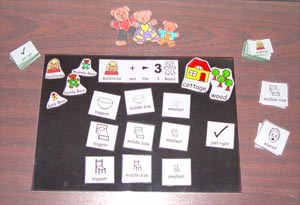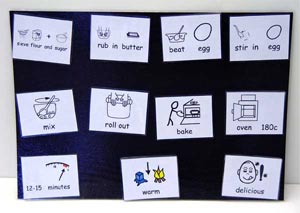Practical Guides
Using Storyboards
Introduce symbols first and encourage children to say what they think the symbols might mean.
As the adult tells the story she/he points to the symbols on the storyboard. Opportunities are available for animating the story and characters. Using small pieces of Velcro or blu-tac enables characters (finger puppets) to be moved along the board. For example in the Goldilocks story small pieces of Velcro/ blu-tac attached next to biggest bowl, medium size bowl, and smallest bowl allows Goldilocks to be placed next to these symbols reinforcing key vocabulary. This makes the storyboard even more appealing to the children whilst they are listening to the story and when they eagerly re-tell afterwards. It encourages less confident children to participate.
Another idea could be to start with an empty storyboard and fill as the story unfolds making sure that the symbols have first been introduced.
Storyboards may also be used as an activity with the children afterwards to encourage story sequencing.
Talk about initial phonemes in the words on the board and have another set with the symbol and the word on to refer to. Ask the children to find the matching word.
When the story is finished the storyboard can be used to reinforce key concept words. For example in Goldilocks the teacher could ask, "What was wrong with Daddy Bear's porridge?" The children are encouraged to refer to the symbols if needed to give the answer, too HOT. Other key concept words in this story could be cold, high/low, hard/soft.
Individuals and small groups

Smaller tabletop versions can be used to encourage independent writing and can be used with individuals/small groups working on their own or supported by a teaching assistant. Tabletop versions can also help support older children with Special Needs.
Follow up activities
There are lots of opportunities to produce follow up activities to go with Storyboards depending on the story being demonstrated. For example:
- the 'Gingerbread Man' recipe cards showing ingredients for gingerbread biscuits can me made and mounted onto board for a sequencing activity.
- lotto/Pairs games can be produced to reinforce vocabulary from the story.
- in the Goldilocks story children can use part of a Design and Technology lesson to design and make different size chairs for the bears.
- the children can also have a go at making their own storyboard.
- on screen environments can also be used for children who have difficulty recording a story.

Storyboards | Using Storyboards | Making Storyboards | Activity Outcomes
